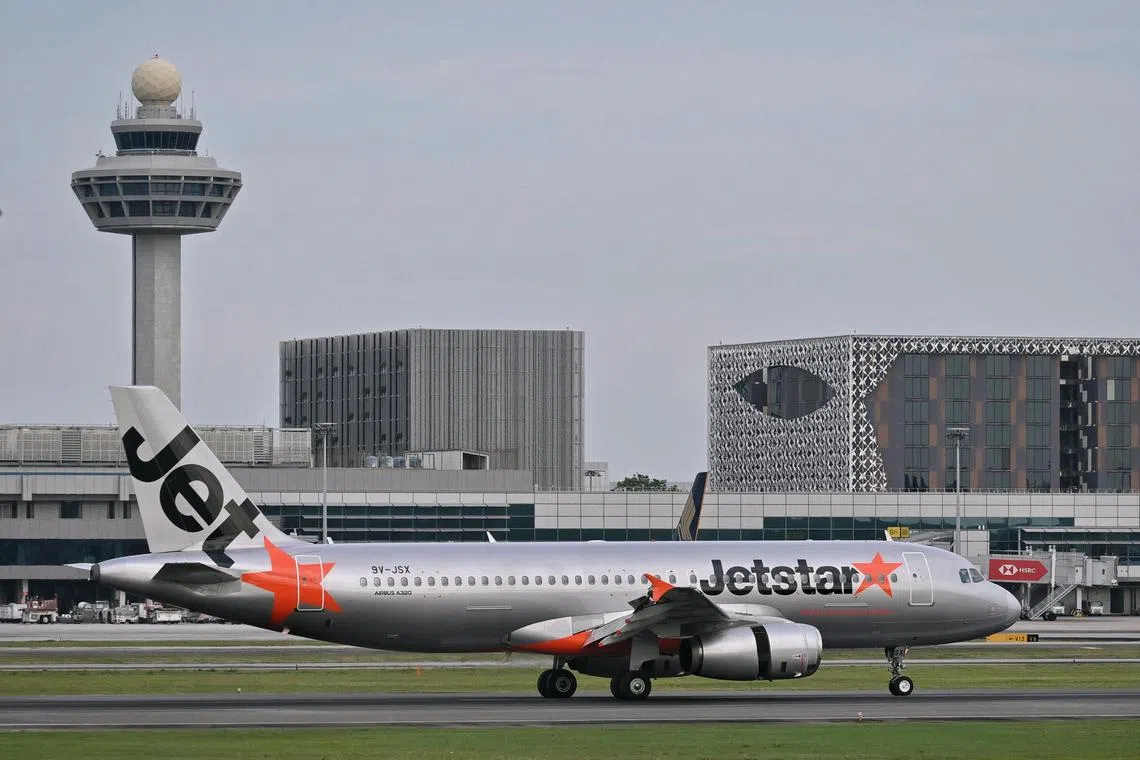South-east Asia's budget airlines bet on travel demand, despite competition woes
Sign up now: Get ST's newsletters delivered to your inbox

Rising cost pressures are squeezing profitability and led Qantas Airways to shut down Singapore-based Jetstar Asia.
PHOTO: ST FILE
Follow topic:
SEOUL - South-east Asia’s biggest budget airlines are pursuing a bruising capacity expansion race despite rising cost pressures that are squeezing profitability and led Qantas Airways to shut down Singapore-based offshoot Jetstar Asia.
Low-cost carriers have proliferated in Asia in the past two decades as disposable incomes rise, supported by robust travel demand from Chinese tourists.
Demand for air travel in Asia is expected to grow faster than other regions in the next few decades, and carriers like Vietnam’s VietJet Aviation and Malaysia-headquartered AirAsia are to buy more planes to add to their already large order books as they seek to gain market share.
But margins are thinner than in other regions.
The International Air Transport Association (Iata), an airline industry body, expects Asia-Pacific airlines to make a net profit margin of 1.9 per cent in 2025, compared with a global average of 3.7 per cent.
Airlines across Asia have largely restored capacity since the Covid-19 pandemic, which has intensified competition, especially for price-sensitive budget travellers, and pulled airfares down from recent high levels.
International airfares in Asia dropped 12 per cent in 2024 from 2023, ForwardKeys data shows.
AirAsia, the region’s largest budget carrier, reported a 9 per cent decline in average airfares in the first quarter as it added capacity and passed savings from lower fuel prices on to its customers.
Adding to challenges for airlines, costs such as labour and airport charges are also rising, while a shortage of new planes is driving up leasing and maintenance fees.
This shifting landscape is what prompted Australia’s Qantas to announce last week that the loss-making low-cost intra-Asia subsidiary Jetstar Asia would shut down by the end of July after two decades of operations.
Jetstar Asia said it had seen “really high cost increases” at its Singapore base, including double-digit rises in fuel, airport fees, ground handling and security charges.
Iata Asia-Pacific vice-president Sheldon Hee said that “it is a very thin buffer, and with margins this low, any cost increase can impact an airline’s viability”, adding that operating costs were escalating in the region.
Aviation data firm OAG in a February white paper said the Asia-Pacific was the world’s most competitive aviation market, with airfares driven down by rapid capacity expansion “perhaps to a point where profits are compromised”.
“Balancing supply to demand and costs to revenue have never been more critical,” the report said of the region’s airlines.
‘Go big or go home’
South-east Asia has an unusually high concentration of international budget flights.
Around two-thirds of international seats within the region so far in 2025 were on budget carriers, compared with about one-third of international seats globally, Capa Centre for Aviation data shows.
Analysts say Qantas took the option to move Jetstar Asia’s aircraft to more cost-efficient operations in Australia and New Zealand rather than continue to lose money.
Asia-based independent aviation analyst Brendan Sobie said that budget operators in South-east Asia were struggling for profits amid fierce competition even before the pandemic, and now there is the added factor of higher costs.
Low-cost carriers offer bargain fares by driving operating costs as low as possible. Large fleets of one aircraft type drive efficiencies of scale.
Jetstar Asia was much smaller than local rivals, with only 13 aircraft.
As at March 31, Singapore Airlines’ budget offshoot Scoot had 53 planes, AirAsia had 225 and VietJet had 117, including its Thai arm. Low-cost Philippine carrier Cebu Pacific had 99.
All four are adding more planes to their fleets in 2025 and further into the future.
VietJet on June 17 signed a provisional deal to buy up to another 150 single-aisle Airbus planes at the Paris Airshow, in a move it said was just the beginning as the airline pursues ambitious growth.
The deal comes weeks after it ordered 20 A330neo wide-body planes, alongside an outstanding order for 200 Boeing 737 Max jets.
AirAsia chief executive Tony Fernandes said on June 18 that the carrier, which has an existing order book of at least 350 planes, is also in talks to buy 50 to 70 long-range single-aisle jetliners, and 100 regional jets that could allow it to expand to more destinations.
Association of Asia-Pacific Airlines director-general Subhas Menon said: “At the end of the day, it is go big or go home.” REUTERS

